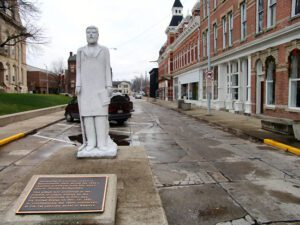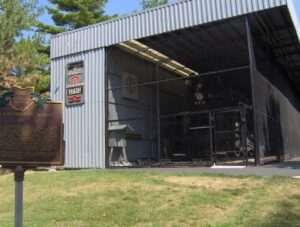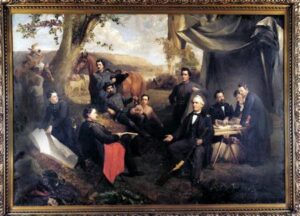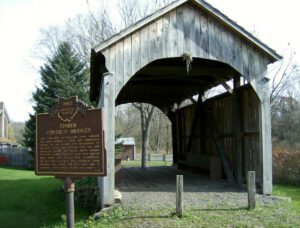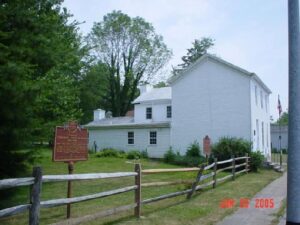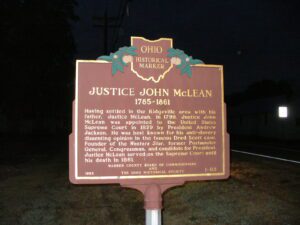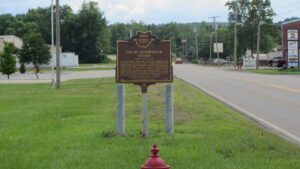, OH
America’s first concrete streets were those which surrounded this court house. Concrete was first used in 1891 to provide an 8-foot strip along Main Street where horses were hitched. Two years later Court Avenue was paved with concrete made from native marl supplied by the Buckeye Cement Company, 8 miles to the northeast. This marker was erected in 1968 at the 75th anniversary of the paving of Court Street.
, OH
One of America’s largest and best known steam locomotive builders, the Lima Locomotive Works built 7,752 locomotives between 1879 and 1951. It rose to success building the patented Shay geared locomotive, an innovative design that became the standard for railroad logging. In the early 20th century Lima began building mainline locomotives, exemplified by the “Super-Power” 2-8-4 Berkshire, which used superheated steam and an enlarged firebox for unprecedented power and speed. Introduced in 1925, it showcased Lima’s technological prowess. The “loco works” employed workers of many nationalities, fostering a legacy of ethnic diversity in Lima. Often several generations of the same family worked in the same shop, a practice that encouraged loyalty and a tradition of craftsmanship passed to succeeding generations.
, OH
Major Daniel McCook of Carrollton and his 9 sons and their cousins, the 5 sons of Dr. John McCook of Steubenville, won popular acclaim for their outstanding service in the United States Army and Navy. “Tribe of Dan” Maj. Daniel: mortally wounded at Buffington Island. Maj. Latimer: a surgeon. Brig. Gen. George: early regimental commander. Midshipman John: died at sea. Brig Gen. Robert: murdered by guerrillas. Maj. Gen. Alexander: commander of the 20th Corps. Brig. Gen. Daniel Jr. mortally wounded at Kenesaw Mt. Maj. Gen. Edwin: served under Grant and Sherman. Pvt. Charles: killed at Bull Run. Col. John: seriously wounded in Virginia.
, OH
“Wind increasing in volume. Get no chance to . . . ” These were the last words from the doomed Navy airship Shenandoah, caught in a violent storm and crashing 7 miles southwest of this spot near Ava at dawn, September 3, 1925. Fourteen of its crew were killed. While souvenir hunters stripped the wreckage, a nation questioned the value of huge, rigid dirigibles, the last crashing in 1935. Smaller blimps replaced the dirigible as America’s lighter-than-air sentinels of the sky.
, OH
This covered bridge, over Middle Run, Elkrun Township, Columbiana County, is the shortest covered bridge in the United States still standing on a once-used public highway, having a clear span of 19 feet and 3 inches. It is an example, rarely found covered, of the simplest, most basic truss design, the two-panel king post truss. It has withstood the rigors of time and traffic since the 1870s and stands in eloquent testimony of the fine craftsmanship of the early Ohio bridge builders.
, OH
U.S. Grant, general-in-chief of the Armies of the United States, 18th president and first native Ohioan to be elected chief executive, lived in this house from 1824 to 1839. Jesse R. Grant, his father, built the original part fronting Water Street in 1824 and later built an addition fronting Main Cross Street, now Grant Avenue. “This place remained my home, until at the age of seventeen, in 1839, I went to West Point.” Memoirs of U.S. Grant
, OH
Having settled in the Ridgeville area with his father, Justice McLean, in 1799, Justice John McLean was appointed to the United States Supreme Court in 1829 by President Andrew Jackson. He was best known for his anti-slavery dissenting opinion in the famous Dred Scott case. Founder of the Western Star, former Postmaster General, Congressman, and candidate for President, Justice McLean served on the Supreme Court until his death in 1861.
, OH
Here, on April 10, 1779 during the Revolutionary War, David Zeisberger founded one of the five Delaware Christian missions to occupy the Tuscarawas Valley between May 3, 1772 and September 8, 1781. Living at the Lichtenau mission near the Delaware capital of Goschachgunk (presently Coshocton, Ohio), Zeisberger feared that the Delaware nation was about to break their neutrality and join the British led Indians. Accordingly, he decided to disperse his Christian congregation and move his converts thirty-five miles up river to a place of safety in this large alluvial plain adjacent to the Tuscarawas River.


